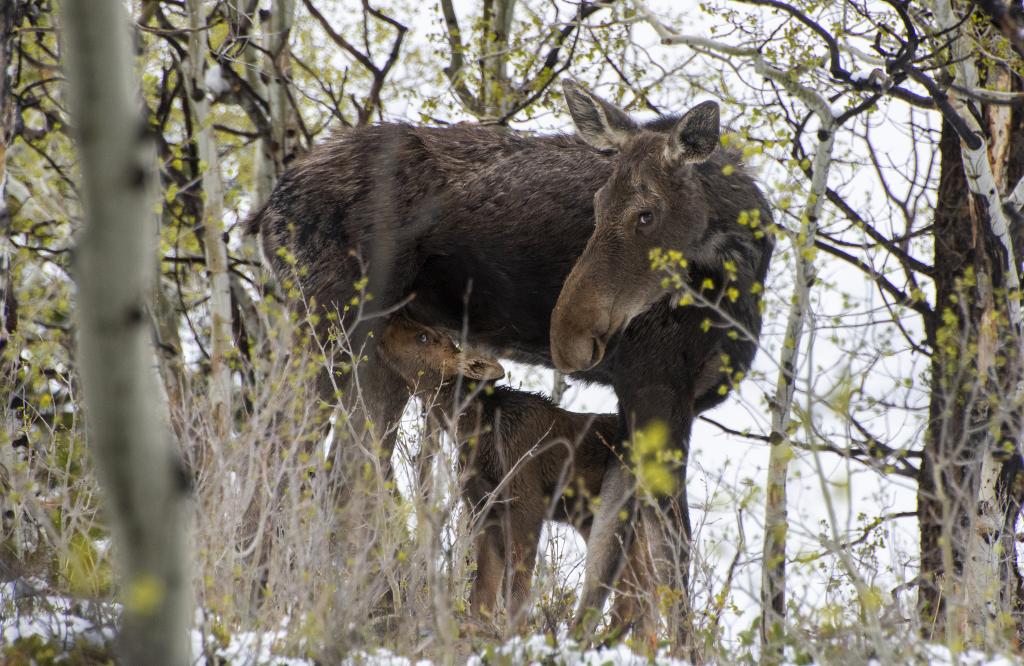Expect aggressive wildlife behavior this time of year from mothers defending their young

 Jason Clay
Jason ClayNortheast Region Public Information Officer
303-291-7234 / [email protected]
@CPW_NE

DENVER - Many birds and mammals give birth this time of the year. Now through the end of June, newborn wildlife will be found across the landscape and it is important that when they are observed, that people do so from a distance and never try to interact with them.
Colorado Parks and Wildlife officials issue this annual advisory to avoid elk, moose and deer that have newborn calves and fawns this time of year.
There have been two recent moose attacks that resulted in injuries to people in northwest Colorado, both of which were from cows exhibiting defensive behavior of their nearby calves. One was on a woman running on a trail in Breckenridge on May 26. The second was on May 31 in Grand Lake when a woman encountered a moose five-feet away in some willows near her home. As she started running away, she fell down and then felt the moose stomp on her back and head.
These incidents serve as examples that wildlife are just that, wild, and they can act in unpredictable ways. CPW reminds the public to respect wildlife and their space, especially this time of the year.
“Cows will be exhibiting normal protective behavior of their young,” said Shannon Schaller, Deputy Regional Manager with CPW’s Northeast region. “Give wildlife extra space this time of year. Be sure to keep dogs on leashes. Dogs can trigger aggressive behavior and both moose and elk will chase a dog right back to their owner, presenting a dangerous situation.”
Having dogs off leash often escalates run-ins with wildlife from just a sighting into what could be a dangerous situation.
“As people are recreating for the next three or four weeks, they should be keeping their dogs on a leash or leaving them at home,” said Kristin Cannon, Deputy Regional Manager with CPW’s Northeast region. “They should be aware of their surroundings and should give all wildlife plenty of space.”
One way to avoid an unnecessary run-in with a moose is to steer clear of thick willow habitat in riparian areas where they are likely to be found eating or resting. Their calves, born in a 3-4 week period from the end of May to mid-June, are often lying in the willows while their mother is off grazing. Calves, which weigh 26-28 pounds at birth, typically gain about two pounds of weight per day, reaching weights of 385-400 pounds by October.
CPW produced a video illustrating how people can be safe and responsible around moose. The video is available on YouTube: https://www.youtube.com/watch?v=q6Qj9K_eJJE&t=2s
Video of a newborn calf with its mother during the May 31-June 1 snow that hit Colorado’s high country: https://youtu.be/B2wk2oHUdas
Elk calves are typically born in locations where cover, forage and water are in juxtaposition in late May or early June. A single calf is typical, twins are rare. Calves weigh between 28-35 pounds at birth and are covered with small white spots for their first few months of their lives.
On Wednesday, wildlife officers rescued a elk calf out of a window well in Genesee Village.
People that feed, touch or remove wildlife from their natural environment actually cause them harm and are not helping the young animals. The best practice is to leave young wildlife alone, untouched in their natural habitat so they can grow and thrive in the wild.
On Friday in Evergreen, wildlife officers had to take a fawn from a resident who thought it was abandoned.
If you see a newborn fawn without its mother nearby, that is normal. Deer, elk and pronghorn mothers hide their young for long periods of time while foraging. Young that have been removed cannot be successfully returned to the wild, as the mother will not continue searching for a missing baby or reject it because it was handled by humans and may no longer smell like her fawn.
How can humans help young wildlife?
-
Do not approach, touch or feed wild animals.
-
Enjoy wildlife from a safe distance.
-
Keep your dog on a leash and on trails.
-
If you find a wild animal that appears sick or injured, leave it alone. Call your local Colorado Parks and Wildlife office and talk to a trained wildlife official for guidance.
For more information, please visit our website with spring wildlife advice.
Photos Below (courtesy of CPW)
Left: An elk calf that fell down a window well in Genesee Village on Wednesday.
Right: A deer fawn from Evergreen on Friday that wildlife officers took from a resident who thought they were rescuing it.


Colorado Parks and Wildlife (CPW) is an enterprise agency, relying primarily on license sales, state parks fees and registration fees to support its operations, including: 43 state parks and more than 350 wildlife areas covering approximately 900,000 acres, management of fishing and hunting, wildlife watching, camping, motorized and non-motorized trails, boating and outdoor education. CPW's work contributes approximately $6 billion in total economic impact annually throughout Colorado.
DISCLAIMER: The Colorado Parks and Wildlife (CPW) website maintains press releases containing historical information that may no longer be accurate. Press releases are dated, which should be noted to determine whether the information provided is current. Please review our current regulations and brochures for up-to-date information.